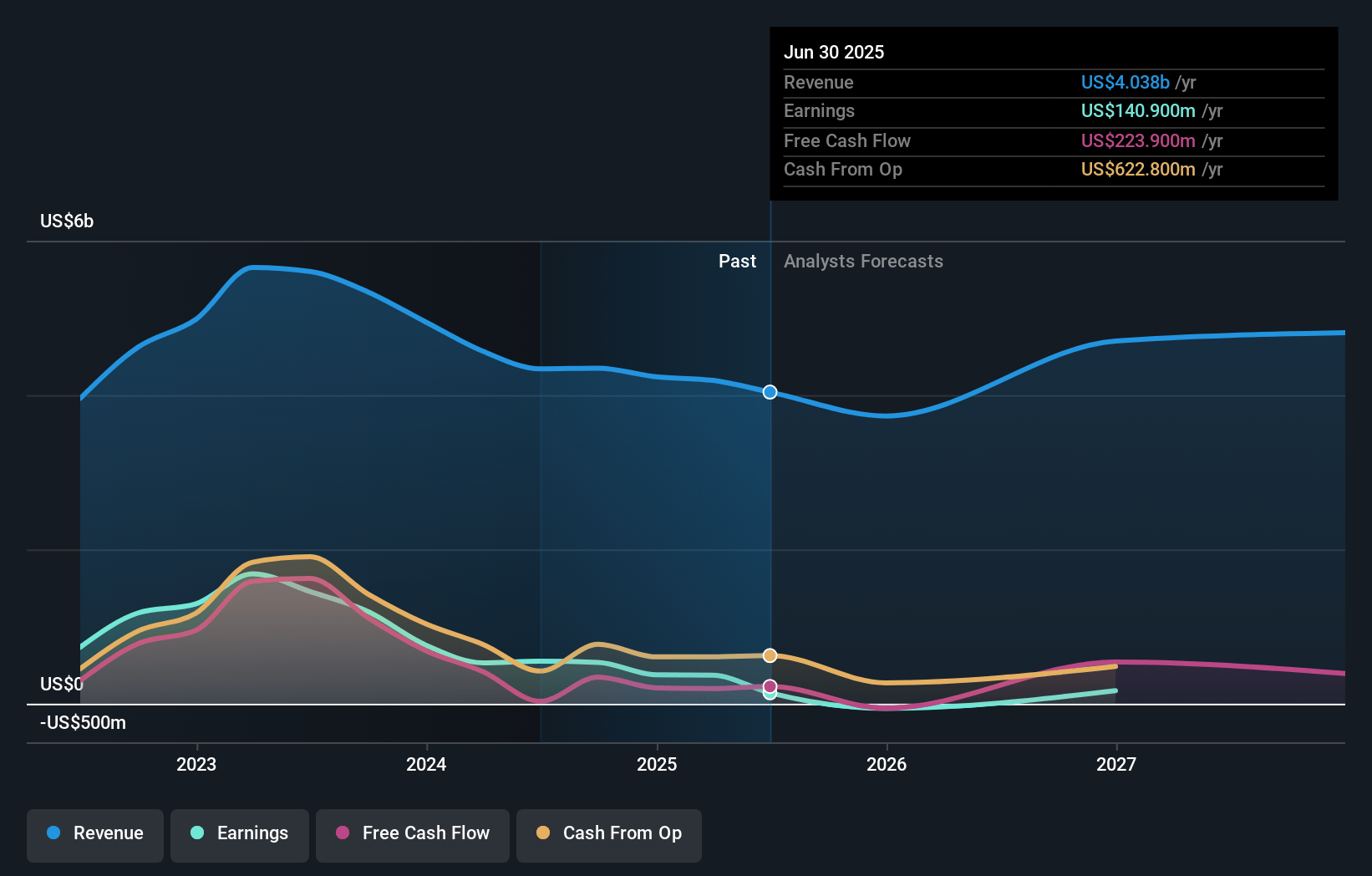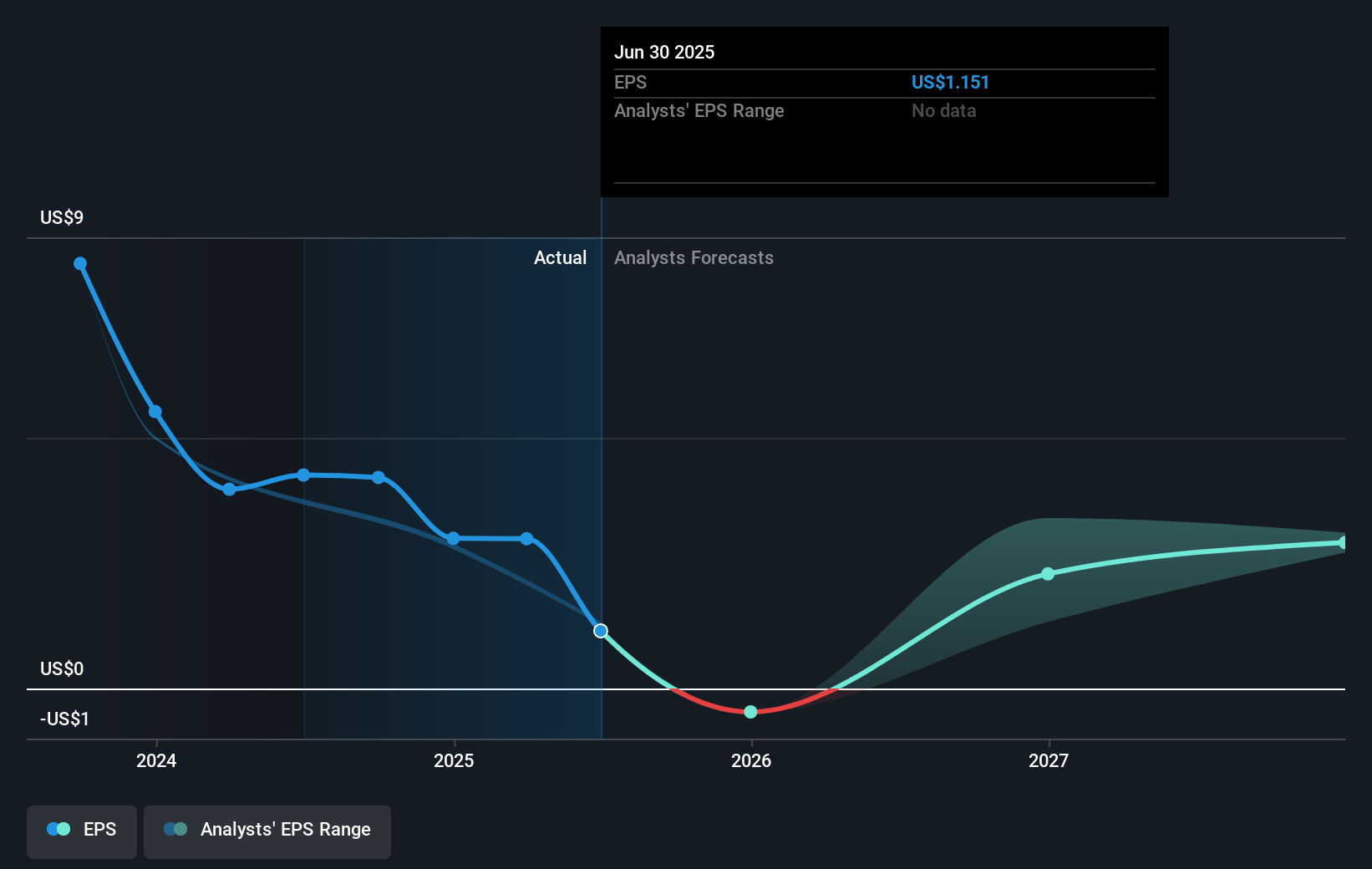Narratives are currently in beta
Key Takeaways
- Accelerated CapEx and early mine closure could negatively affect cash flow and reduce future revenues in key coal segments.
- Volatile coal prices and rising U.S. operational costs pose risks to margins and earnings sustainability.
- Peabody's focus on returning shareholder value and leveraging growing demand in Asia indicates potential for revenue stability and improved financial outcomes.
Catalysts
About Peabody Energy- Engages in coal mining business in the United States, Japan, Taiwan, Australia, India, Brazil, Belgium, Chile, France, Indonesia, China, Vietnam, South Korea, Germany, and internationally.
- The acceleration of the Centurion mine's CapEx spend by $30 million due to faster-than-expected development rates could lead to overestimation of future revenues without the corresponding increase in returns, impacting cash flow projections negatively.
- The decision to close the Wambo underground mine earlier than planned due to challenging geological conditions will result in a production reduction of 400,000 tonnes in 2025, potentially lowering revenues from seaborne thermal coal.
- Withholding significant shipments at Shoal Creek during periods of weak spot prices and logistical challenges may lead to lower near-term revenues, affecting margins due to continued operational costs.
- Continued exposure to volatile metallurgical coal prices due to global market dynamics, such as Chinese steel export impacts, might lead to margins compression in the seaborne metallurgical coal segment.
- Increasing costs in U.S. thermal operations, with new guidance suggesting $2 more per tonne, could result in reduced net margins despite stable shipment volumes, affecting earnings sustainability.
Peabody Energy Future Earnings and Revenue Growth
Assumptions
How have these above catalysts been quantified?- Analysts are assuming Peabody Energy's revenue will grow by 1.5% annually over the next 3 years.
- Analysts assume that profit margins will shrink from 12.3% today to 8.6% in 3 years time.
- Analysts expect earnings to reach $392.6 million (and earnings per share of $2.92) by about November 2027, down from $535.9 million today. However, there is a considerable amount of disagreement amongst the analysts with the most bullish expecting $581 million in earnings, and the most bearish expecting $320.7 million.
- In order for the above numbers to justify the analysts price target, the company would need to trade at a PE ratio of 12.4x on those 2027 earnings, up from 6.3x today. This future PE is greater than the current PE for the US Oil and Gas industry at 11.0x.
- Analysts expect the number of shares outstanding to grow by 3.4% per year for the next 3 years.
- To value all of this in today's terms, we will use a discount rate of 7.24%, as per the Simply Wall St company report.
Peabody Energy Future Earnings Per Share Growth
Risks
What could happen that would invalidate this narrative?- Peabody's achievements in seaborne thermal and U.S. thermal segments, and the completion of $100 million in share repurchases, indicate a strong commitment to returning value to shareholders, potentially supporting share price stability through increased investor confidence. (Revenue and earnings)
- Growing demand for thermal coal, particularly in Asia, has bolstered spot pricing, and the International Energy Agency's forecast for higher coal consumption in 2030 suggests a steady market for Peabody's products. (Revenue and net margins)
- The operational turnaround at Shoal Creek with the Black Warrior River's re-opening provides an opportunity for improved shipment volumes and, consequently, better financial outcomes. (Earnings and revenue)
- The strategy of opportunistic sales and improved cost management in U.S. thermal coal operations indicates agile operations that could enhance profitability even in a challenging market. (Net margins and earnings)
- The resilience of seaborne thermal coal pricing, along with the increased restocking demand in the Asia Pacific region, suggests the possibility of sustained or improved revenue from these markets. (Revenue and net margins)
Valuation
How have all the factors above been brought together to estimate a fair value?- The analysts have a consensus price target of $29.4 for Peabody Energy based on their expectations of its future earnings growth, profit margins and other risk factors. However, there is a degree of disagreement amongst analysts, with the most bullish reporting a price target of $33.0, and the most bearish reporting a price target of just $26.0.
- In order for you to agree with the analyst's consensus, you'd need to believe that by 2027, revenues will be $4.6 billion, earnings will come to $392.6 million, and it would be trading on a PE ratio of 12.4x, assuming you use a discount rate of 7.2%.
- Given the current share price of $27.66, the analyst's price target of $29.4 is 5.9% higher. The relatively low difference between the current share price and the analyst consensus price target indicates that they believe on average, the company is fairly priced.
- We always encourage you to reach your own conclusions though. So sense check these analyst numbers against your own assumptions and expectations based on your understanding of the business and what you believe is probable.
How well do narratives help inform your perspective?
Disclaimer
Warren A.I. is a tool utilizing a Large Language Model (LLM) that ingests data on consensus price targets, forecasted revenue and earnings figures, as well as the transcripts of earnings calls to produce qualitative analysis. The narratives produced by Warren A.I. are general in nature and are based solely on analyst data and publicly-available material published by the respective companies. These scenarios are not indicative of the company's future performance and are exploratory in nature. Simply Wall St has no position in the company(s) mentioned. The price targets and estimates used are consensus data, and do not constitute a recommendation to buy or sell any stock, and they do not take account of your objectives, or your financial situation. Note that Warren A.I.'s analysis may not factor in the latest price-sensitive company announcements or qualitative material.
Read more narratives
There are no other narratives for this company.
View all narratives



